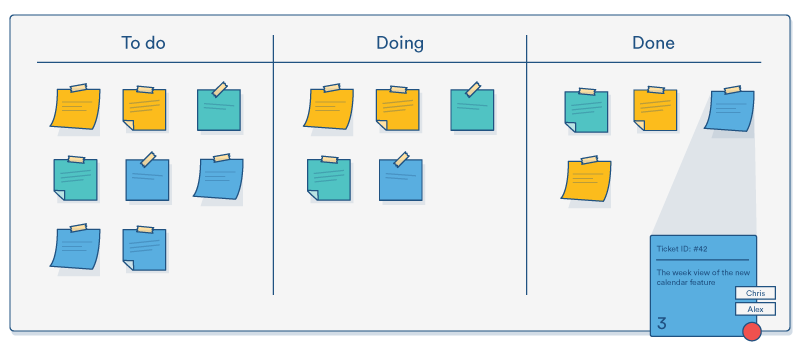How to get your things done? Here are top 7 ways to Juggle Multiple Projects
Introduction
Juggling the balls into the air is something, which requires a set of skills, doesn’t it? But the most important is, how many balls together can you juggle into the air without dropping any of them? – Challenge is - how to handle multitasking job?
The above statements pose to you a good analogy. When you are working on multiple projects at once and you need to juggle these projects at your work to manage them well. Thus, it becomes essential to know - how do you manage multiple projects?
Why is it important to manage multiple projects?
In today’s scenario, most of us are bundles with so many projects at one point in time. Believe me, no project manager has got the luxury to handle only single project at a time. So, now consider yourself. Are you also facing these challenges to juggle multiple projects at work? If yes, are you good enough to get your project tasks done on time? If you are struggling to juggle multiple projects, then you are at right column – describing, how to handle multiple projects!
At the workplace, we are supposed to handle multiple projects and expected to deliver the results efficiently. But that’s easy to say than done. From my experience, I can tell you, managing multiple projects is a skill, which cannot be developed overnight. It requires you to practice a lot to have a good command over it. The very first step is to assess yourself – returning back to my very first question – How many balls can you juggle into the air at a time? i.e. how many projects should a project manager manage? This is very important to know your capabilities on a number of project tasks that you can handle at a time. If you know your limits, don’t try to overstretch yourself beyond your limits. I have put together some of the tips and suggestions, you can follow to ace the skills on how to manage multiple projects at once.
How to manage multiple projects at work?
Top 7 useful tips for you, which will help you in juggling multiple projects at work:
1) Plan and prioritize your projects
a). Let’s learn- how to organize work projects? List down all the ongoing projects on a sheet of paper in one column. Draw Four more columns with the heads – Due time for each project, Project Tasks, Time expected by tasks and Actual Time Taken as shown below in figure 1:
| Projects | Due time for the project | Project Tasks | Time allotted by project tasks | Actual Time Taken |
| Project1 | “X” hours | Task 1 | “Y” hours | |
| Task 2 | “Z” hours | |||
| Project2 | “A” hours | Task 1 | “B” hours |
Figure 1: Project to-do table
Now, you can understand, how valuable this matrix is? This matrix will never let you forget any ongoing projects/ project tasks and will always remind you about – what all projects are going on; what projects are pending; Are you completing your project tasks as scheduled and so on.
Takeaway:
How to handle multiple tasks at work by proper scheduling?
It is always the best practice to break down projects into easily manageable tasks. Try to break your daily projects into small crunches and allocate some time frame to these individual tasks. As a precautionary step, always have the habit to add a cushion of 15 – 20% in allotted time for each task. For example, if any task takes 60 minutes to complete – allot a time of 75 minutes for this task. But always remember, this time relaxation should not slow down your speed to complete that task! Take the advantage of this cushion to ensure that you deliver your projects on time, despite any unplanned and unavoidable distractions.
Also, note that the last column of this table, “Actual Time Taken” will keep you on track, so that in case of conflicts, you can take some necessary course correction in your task timings. Other project tracking tools like Gantt chart or PERT chart can also be used to closely monitor the project progress for complex projects.
b). Next, how do you prioritize your workload? - It makes a significant difference! Having listed all projects and related tasks, next step is to shuffle these tasks by setting the priorities. As you know, not all the tasks are equally important. Some tasks need attention on an immediate basis, while others have the liberty to attend them later. Map all the tasks and check, which tasks are most urgent. The best way to prioritize projects’ tasks is to assign urgency levels for these tasks as 1, 2 and 3. Where level 1 depicts “Most urgent”, level 2 “Urgent but not on high priority”, and level 3 “Not so urgent”. This classification will help you to sort these tasks and schedule them accordingly. This way you are strategizing out a plan for all your ongoing projects.
c). After prioritizing these tasks and setting the deadlines, a better approach is to check them with your manager and peers to nullify any chances of contradiction. Also, checking your project management tasks list with seniors will keep them acknowledged about – “what are you doing” and at the same time, it keeps you confident that you are performing the most important tasks. Hence, you are managing all the tasks effectively and proving yourself resourceful.
2) Avoid distractions at your workplace
Don’t let you anything distract you, which doesn’t add any value to your projects. Always, concentrate on the task at hand. A better approach is to keep your mail and message notifications in silent mode if they are not related to your project tasks. You can also notify relevant people that for a particular duration you are unable to read their messages and if there is any urgency, people can call directly on your cell phone. This way you make the people feel that by not replying their messages, you are not avoiding them or disrespecting them. But rather it’ll make them think twice or thrice – is their message really so urgent to make a call right now?
3) Say NO
Inculcate the habit to say “No” to further project tasks, if you are already loaded with multiple tasks. I’ve seen many people having the habit to accept loads of projects from their manager and later find no room to juggle all of them. Just recall, I’ve mentioned at the start - you should assess yourself and know your limits on managing multiple projects. Don’t try to bypass this limit by just accepting the projects as and when they are assigned. Check your task table (Figure 1) and decide – if there any room to take further assignments? This way you can optimize yourself and build credibility among your peers by always effectively juggling the projects assigned to you.
4) Focus on one task or activity at a time
To do two things at once is to do neither. As scheduled by you during planning and prioritization, keep your focus intact. While working on a particular task at a time, don’t let your mind wander for any other task or unnecessary thoughts. Before performing a particular project task, prepare yourself with necessary resources, so that you don’t get deviated and don’t lose your time in finding them while on task.
5) Delegation
Delegate tasks to the people and empower them. Some of the project tasks may require skills, which you can delegate to relevant persons. This way you can distribute your big chunk of tasks to your people. Make them responsible for assigned tasks and don’t micromanage these tasks by yourself. It is always better to empower your people and give them the opportunity to learn and grow. This will also earn you the respect of the people under you. After assigning the tasks, decide for the communication channel to get the regular updates on assigned tasks from each of your subordinates.
6) Take help of tools
Kanban system is an effective tool to remind your daily tasks. Kanban board in the front of the desk in your cube will help to notify you the tasks to be performed in a day. Kanban board is a Japanese system, primarily used for managing the inventory. It’s a display board with sticky notes on it. Each sticky note mentions one task. In order to better comprehend the task status as well, you can divide this board into three columns – “Tasks for the day – To do”, “Ongoing Tasks - Doing” and “Completed tasks - Done”. You can move the sticky notes among these three columns as per the task status during the day. Also, you can assign color coding for the tasks – say, “Yellow” Sticky notes for “Most urgent”, “Green” for “Urgent but not on high priority”, and “Blue” for “Not so urgent” tasks. Figure 2 depicts the Kanban board to manage your tasks daily.

Image Source: https://sites.google.com/site/wcfpandu/what-is-kanban
Figure 2: Kanban Board on your desk helps you with - how to manage things on day – to – day basis
7) Manage your stress
Learn to manage your stress, when you are working on multiple projects at once. Set aside a short break time for 5 – 10 minutes in between two tasks, while scheduling. Get relaxed and stretch your arms after completing each task of short duration. If you have just worked on a task of long duration, say 2 - 3 hours or more, buy yourself a time of 10 – 15 minutes to relax and you may reward yourself a cup of tea or coffee.
Conclusion
To be successful in your career or for your career growth, juggling multiple projects is a key. Not only in professional life but also in your personal life, you tend to juggle multiple tasks in your daily routine. So, it is important to learn – how to juggle multiple projects and how to manage a project’s multiple tasks effectively. Remember these tips - Start with planning and prioritizing the projects’ tasks; Avoid distractions; Don’t get overloaded with projects beyond your limit; concentrate on single task at a time; Delegate tasks; Arrange your tasks in Kanban Board to increase visibility and Keep yourself calm, while juggling with lots of projects and tasks.
Establish your credibility in handling multiple projects – Get Certified Now!
